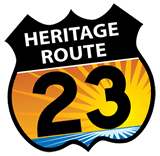•Twigs with alternate leaves / buds (Fig. 1 and 2)
•Leaves often vaguely triangular or oval-ish (Fig. 2 and 3)
•Leaves with big teeth (serrations) around margin; visible on large trees from the ground (if you look closely for leaves against the sky) (Fig. 3)
•Leaves shake / flutter in the wind due to a flat petiole (stem), flattened at the blade (“leaf”) end of the petiole perpendicular to the blade (Fig. 3)
•Flowers – catkins (long, drooping strings of unisexual flowers) in some years (Fig. 4 and 5)
•Flowering time late spring. Leaf out several weeks later than Quaking Aspen and as other trees are leafing, yet they have a light color as they leaf (Fig. 6)
•Trunk on big trees from rough bark at bottom (Fig. 7), to a transition of rough and smooth (Fig. 8), to smooth, tan- colored bark further up (Fig. 9)
•Distinguish Bigtooth Aspen from its close relatives by leaves (Fig. 10)
•Historical uses: pulp
This information is basic (not overly technical) by design and does not include total botanical information about each species (kind of tree). Rather, only distinctive features of each numbered tree in the Alabaster Bike Path-Native Tree Arboretum (ABP-NTA) are listed. Because all natural populations have variation, when considering these trees, look at as many examples of each characteristic as possible, i.e. several leaves or fruits or branching points, etc. Finally, when studying trees, the identifying “keys” are always written for a given geographic area to include ONLY ALL the trees in that area. Because our “area” is (the numbered trees in) the ABP-NTA, this information applies only to the numbered trees along the ABP-NTA; it may or may not work in neighboring areas with even a slightly different species composition. All photos and text by sczaika. Historical uses from Hough, R.B. The Wood Book. Royal Botanical Gardens.










